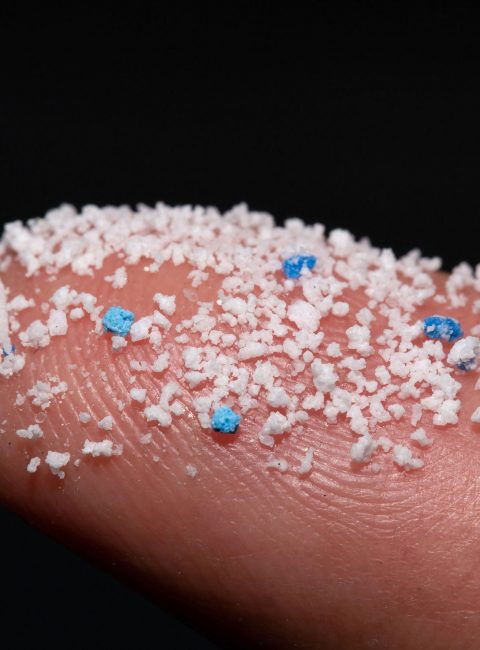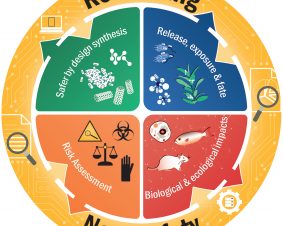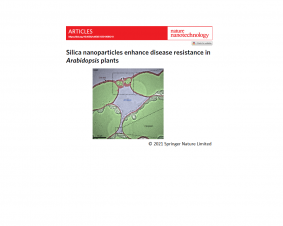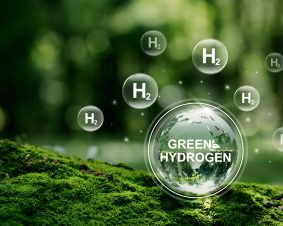 >
Spotlight January 2021: Nanoplastics challenge – How to improve tracking of nanopolystyrene distribution in the environment.
>
Spotlight January 2021: Nanoplastics challenge – How to improve tracking of nanopolystyrene distribution in the environment.
In January, we present a paper published in the Nature Journal communications materials. The article focuses on the development of a new detection method of nanopolystyrene. The method not only makes it possible to detect nanoplastics in the environment for the first time, but also to determine their accumulation in plants and animals.
Nanoplastics, which are added to numerous commercial products or are created by further breaking down microplastics, pose a major threat to our environment. Detection in the environment is difficult for two reasons. First, the small size makes it difficult to detect the particles in the environment. Second, the concentrations are very low. However, tracking nanoparticles is essential to understand potential effects on plants and animals. The team led by Maya Al-Sid-Cheikh has succeeded in improving the detection of nanoplastics by using a special label. To do this, they used a special form of carbon, called 14C, which does not occur naturally. Unlike other labels, e.g. fluorescent dyes, this label cannot be lost, e.g. by fading. By using such 14C-labeled polystyrene particles, the uptake and distribution of nanoplastics in mussels could be tracked for the first time. The 14C-labeled nanopolystyrene could be detected even in very low concentrations, which also allows detection in the environment, e.g. lakes or rivers. The method can be used to better understand the distribution of nanoplastics in the environment and in organisms by means of laboratory experiments. However, it does not allow direct measurement of nanoplastics in the environment because they do not carry the label. As the authors also critically note, it is possible that labeled particles and naturally occurring particles behave differently.
Original publication:
Al-Sid-Cheikh, M., Rowland, S.J., Kaegi, R. et al. Synthesis of 14C-labelled polystyrene nanoplastics for environmental studies. Commun Mater 1, 97 (2020). https://doi.org/10.1038/s43246-020-00097-9

Weitere Spotlights
Spotlight Juli 2020: “Nanosafety – More than just regulatory processes”
Nanosafety is more than just a compulsory aspect of nanomaterials research and regulation. This research area also has great potential to drive new innovations. It is exactly this perspective that is addressed in the special issue “Rethinking Nanosafety: Harnessing Progress and Driving Innovation” by Chen et al. 2020. The article illustrates that especially in the field of […]
Read moreSpotlight December 2021: Silica nanoparticles improve plant disease resistance
The resistance of plants to various pathogens is often increased in agriculture with various chemicals (“fertilizers”). A new direction is being taken with the use of nanoparticles. These can be sprayed on the plants. In the present study, the model plant Arabidopsis was used to investigate whether silicon dioxide nanoparticles (SiO2) can increase resistance to […]
Read moreSpotlight October 2023: Improved hydrogen production through novel catalyst made of three metals
Hydrogen is one of the important energy carriers of the future when it comes to climate-relevant energy supply. For example, surplus electricity from wind turbines or solar plants can be converted into hydrogen, allowing the otherwise unused energy to be stored for longer periods. This hydrogen can be used to power trucks and buses for […]
Read moreSpotlight November 2023: Early Awareness and Action System for Advanced Materials (Early4AdMa)
Advanced materials hold immense potential to address global challenges such as environmental degradation, transformation of the energy sector, and development towards circularity. To harness their benefits while ensuring safety and sustainability, regulatory bodies, scientific communities, and industries have recognized the need for proactive approaches. The “Early4AdMa” system is a pre-regulatory risk governance tool for advanced […]
Read more


